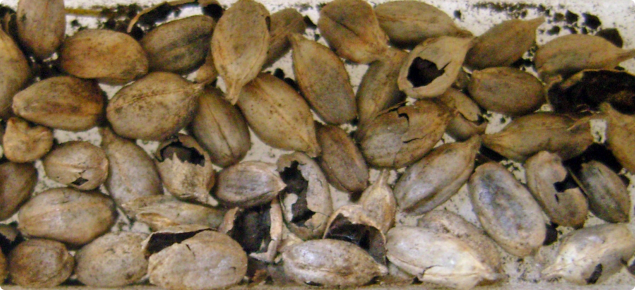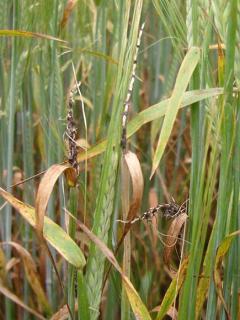The major Western Australian cereal crops, wheat, barley and oats, are susceptible to a range of smut and bunt diseases. Generally, smut diseases are host specific, meaning that smut of one cereal crop will not infect others (for example, loose smut of wheat does not infect barley or oats). Smut diseases have one of two distinct life cycles: internally seed-borne or externally seed-borne. It is important to know the type of smut and its life cycle in order to determine effective control options.
Internally seed-borne smut diseases
Loose smut of barley and wheat are internally seed-borne and carried as a small colony of fungus inside the seed embryo rather than as spores on the seed coat. These are the only internally seed-borne smuts that occur in Australian cereal crops. Contaminated machinery and soil do not transmit these diseases.
Loose smut of wheat and barley
Loose smut of barley (Ustilago nuda) and wheat (Ustilago tritici) are caused by different fungal species specific to the crop they infect, however they have similar life cycles. Infected seed shows no symptoms and appears normal. When infected seed germinates, the fungus becomes active and grows slowly in the growing point of the plant. Diseased plants appear to grow normally but may be slightly taller and earlier maturing than surrounding healthy plants. At heading, the fungus forms a compact spore mass to replace all florets within the cereal head (Figure 1).
All tillers on an infected plant can produce smutted heads and infected plants produce little or no grain. The black powdery spores blow away to leave a bare stalk or rachis (Figure 2). The spores are released as the rest of the crop is flowering. They infect the developing grains of healthy plants and remain dormant until sown the next season. Frequent rain showers and high humidity at flowering favour infection. The higher rainfall southern areas of Western Australia are traditionally the worst areas for loose smut of wheat and barley. Further information is available on the my crop pages: Diagnosing loose smut in wheat and Diagnosing loose smut in barley.
Trials in 2014 and 2015 showed that Hindmarsh is the variety most susceptible to loose smut while La Trobe and Granger are moderately more likely to be affected by loose smut than the varieties Bass, Flinders, Gairdner and Scope CL. Seed of Hindmarsh, La Trobe and Granger should be treated with the seed dressings which provide best control.
Yield loss is directly related to the level of infection in sown seed. Grain receival points accept small quantities of loose smut contamination in wheat and barley before applying dockages.
How to avoid or manage it
The disease is controlled by pickling seed with a systemic fungicide which penetrates the developing seedling to kill the internal infection. Cereal seed dressing fungicides differ in their efficacy for smut management with trial research demonstrating that some seed dressings can reduce the incidence of loose smut in heavily infected seed to nearly zero. The correct application of seed dressings is critical to ensuring adequate control. In-furrow and foliar fungicide applications are not effective. The factsheet - Controlling loose smut of barley, which compares seed dressings, is available from this page.


